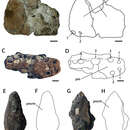Description
provided by Zookeys
Ornithocheirus simus was first described on the basis of a fragmentary anterior portion the premaxillae and maxillae (CAMSM B54428), which remains the best preserved specimen undoubtly referable to this species. This fragment has, in lateral view, a rounded profile, and all preserved tooth sockets are oriented ventrally. Owen (1861) described the specimen in detail and noted its very large size, that its first pair of alveoli were directed downwards, and that the anterior margin of the rostrum is tall above the first pair of alveoli. Owen (1861) thus separated it from Pterodactylus sedgwickii [=Camposipterus(?) MARK123 Camposipterus sedgwickii, see below], in which the first pair of alveoli opens on the anterior margin of the rostrum, facing somewhat forwards, and the anterior margin of the rostrum was not as tall. Owen (1861) also noted that the anterior depression present in the holotype of Ornithocheirus simus was not as marked in another specimen referable to this species. Personal observations of several rostra referable to Ornithocheirus simus (for example, CAMSM B54429, B54552, and B54677, MANCH L.10832, and NHMUK PV 35412) suggest that this depression could have been produced by postmortem abrasion and should be avoided as a character (contra Fastnacht 2001).
Ornithocheirus simus lacks an anterior expansion of the rostrum. As noticed by Owen (1861), there is matrix adhered on the right side of the specimen, which can give the false impression that the palate is broader at the fourth pair of alveoli. Another interesting feature noted by Owen (1861) is the separation between the alveoli of the first pair, equivalent to the largest diameter of the alveolus, and that the bone between these two alveoli projects below from the level of the palate, but not forming an elongated structure. Owen (1861) observed that no median ridge is preserved.
In the original description and illustration, CAMSM B54428 had a tooth preserved in the first left alveolus (Owen 1861: table I, figures 1 to 5). Unwin (2001) suggested that the tooth was possibly glued in this position. During examination of the holotype in 2007, it was observed that the tooth was not preserved with the holotype anymore and could not be found.
Aside from the taxonomic and nomenclatural problems surrounding Ornithocheirus simus, its basic structure is controversial. Several authors considered it a long–snouted animal with a robust premaxillary crest (e.g., Wellnhofer 1987, 1991; Fastnacht 2001; Unwin 2001; Veldmeijer 2006), whereas others have suggested that it was actually a short–snouted pterosaur with a tall and massive rostrum (e.g., Hooley 1914; Arthaber 1922; Kuhn 1967; Kellner 1990). References to a reconstruction as a longirostrine pterosaur with a thick premaxillary crest are based on the alleged similarities between Ornithocheirus simus and the more complete holotype of Tropeognathus mesembrinus Wellnhofer, 1987. As the holotype and the several rostra referable to Ornithocheirus simus are fragmentary, it is very difficult to assess which view is correct. Therefore, we refrained from using the presence or absence of a crest in the diagnosis, but several other features (e.g., tall rostrum, position of the first pair of premaxillary teeth) support the distinctiveness of this species among the Cambridge Greensand pterosaur assemblage and in comparison with Tropeognathus mesembrinus (see Taxa from other deposits, below), leading us to propose here that Ornithocheiridae should be restricted to Ornithocheirus simus.
- license
- cc-by-3.0
- copyright
- Taissa Rodrigues, Alexander Wilhelm Armin Kellner
- bibliographic citation
- Rodrigues T, Kellner A (2013) Taxonomic review of the Ornithocheirus complex (Pterosauria) from the Cretaceous of England ZooKeys 308: 1–112
- author
- Taissa Rodrigues
- author
- Alexander Wilhelm Armin Kellner

